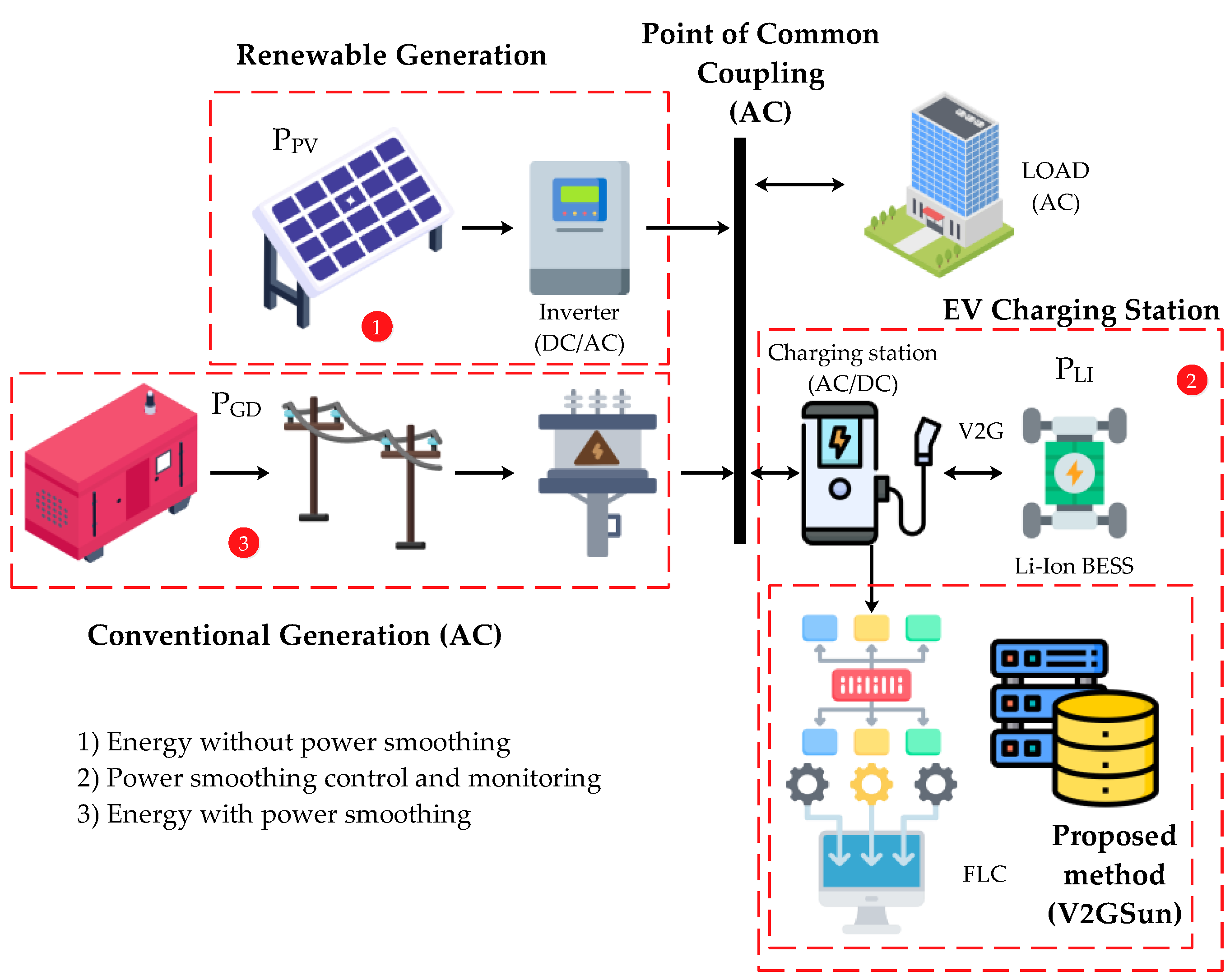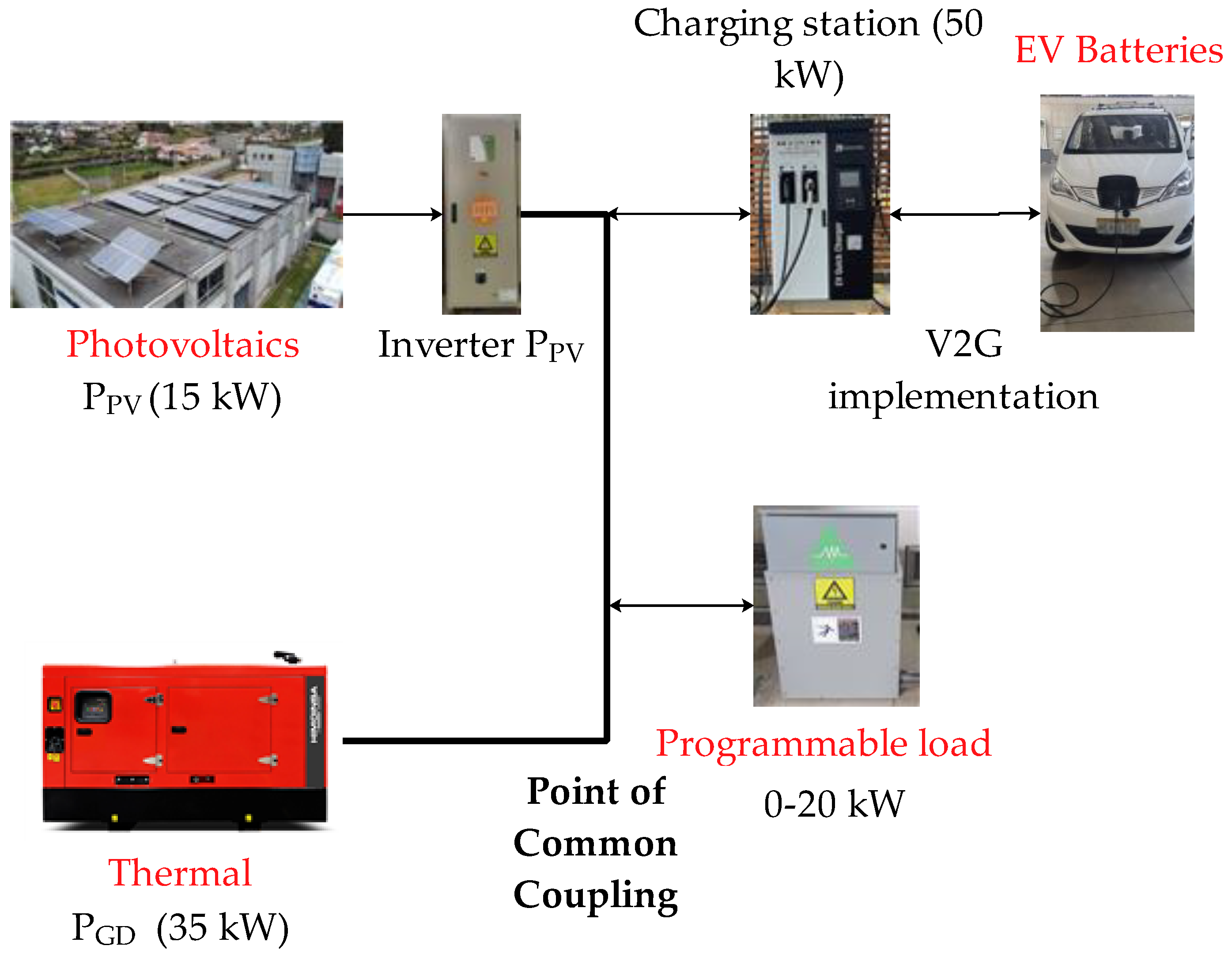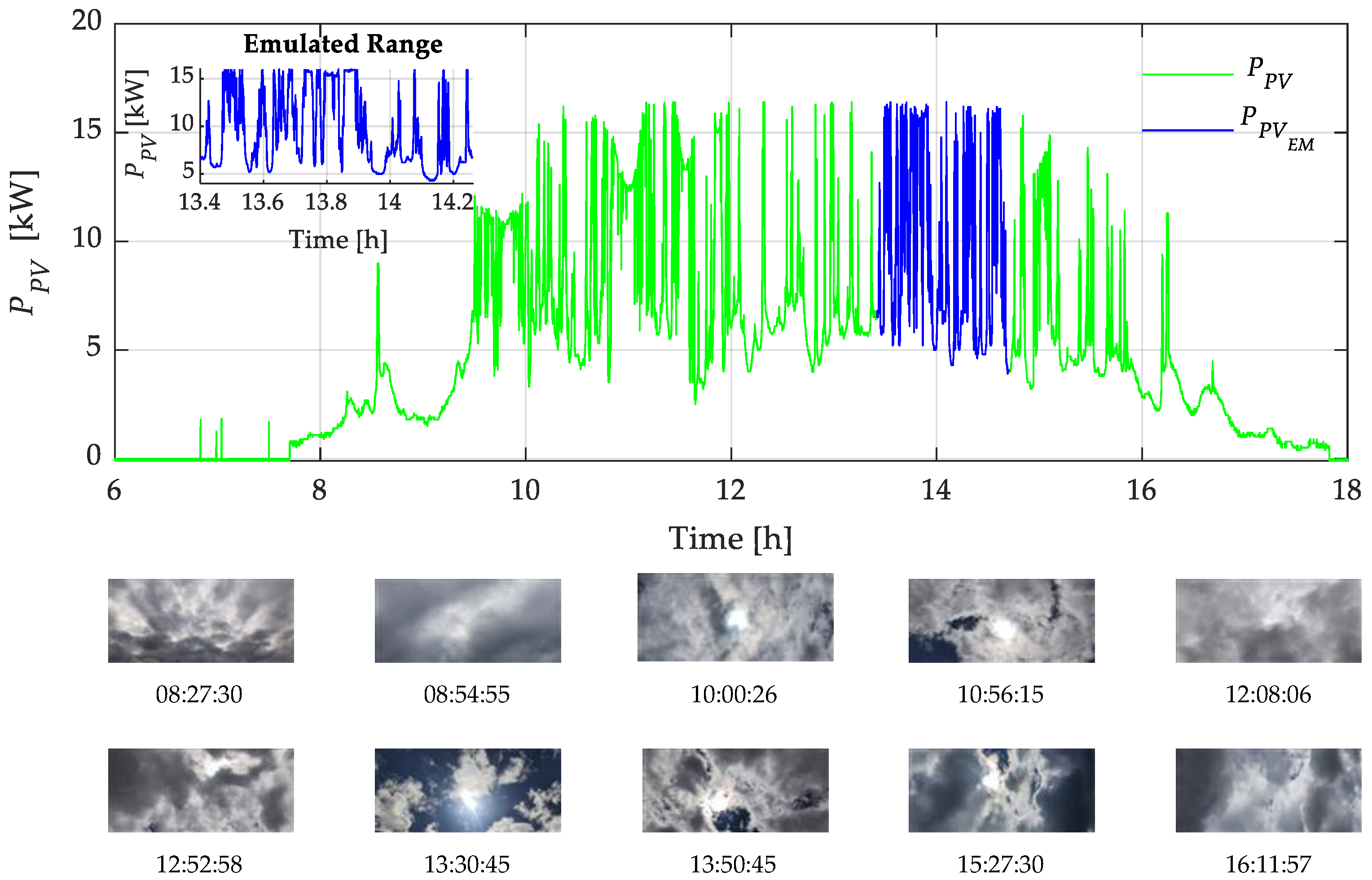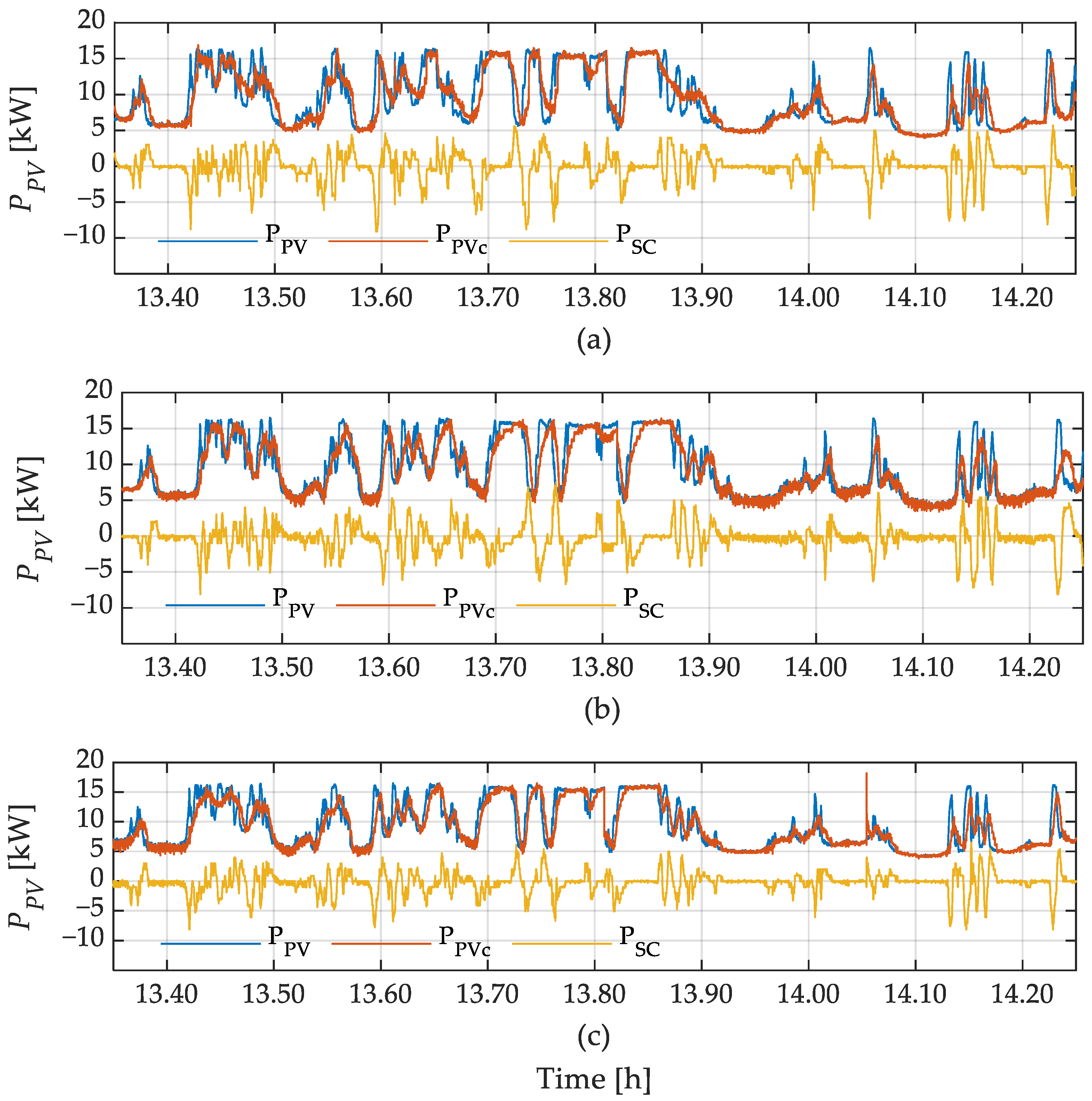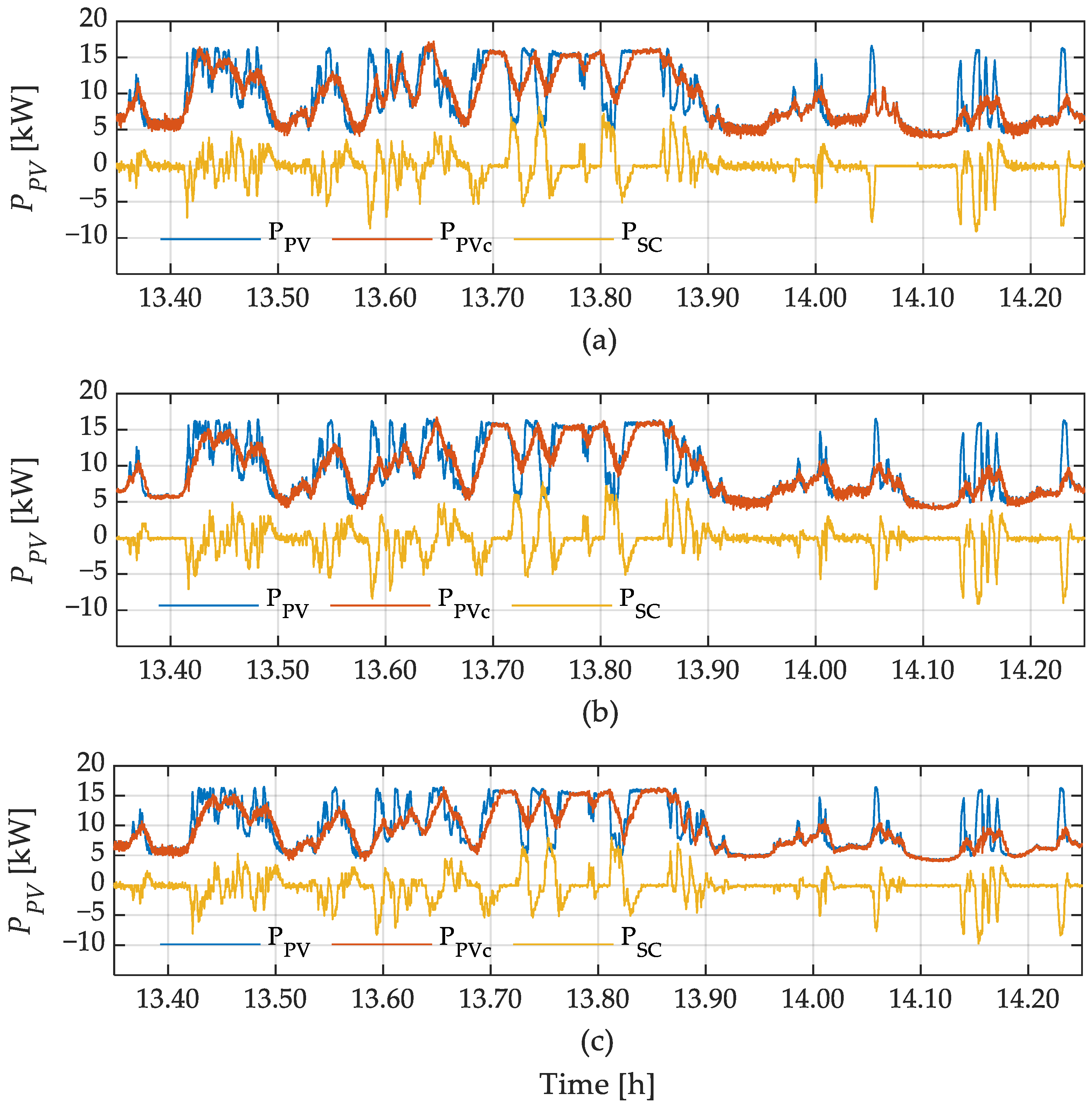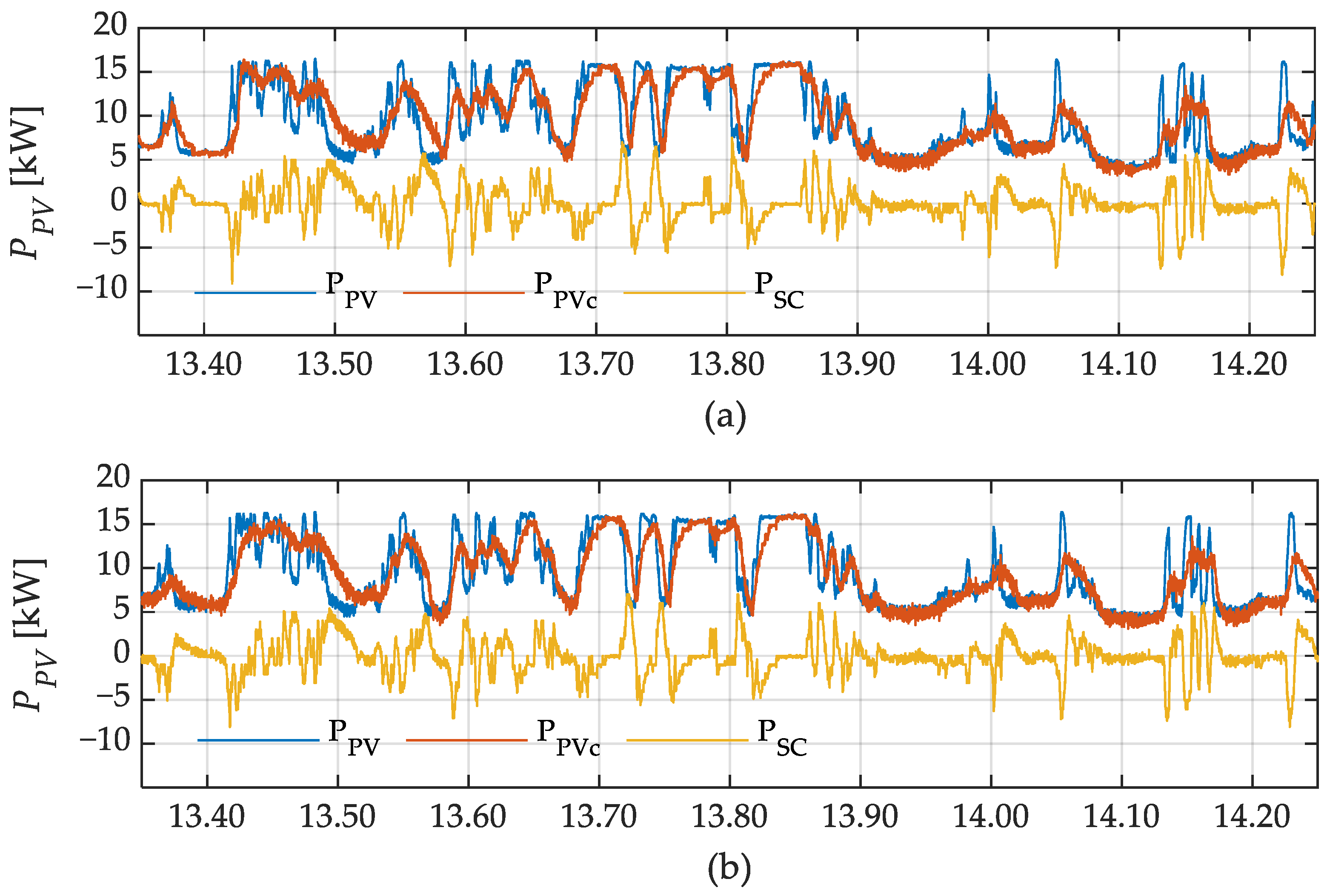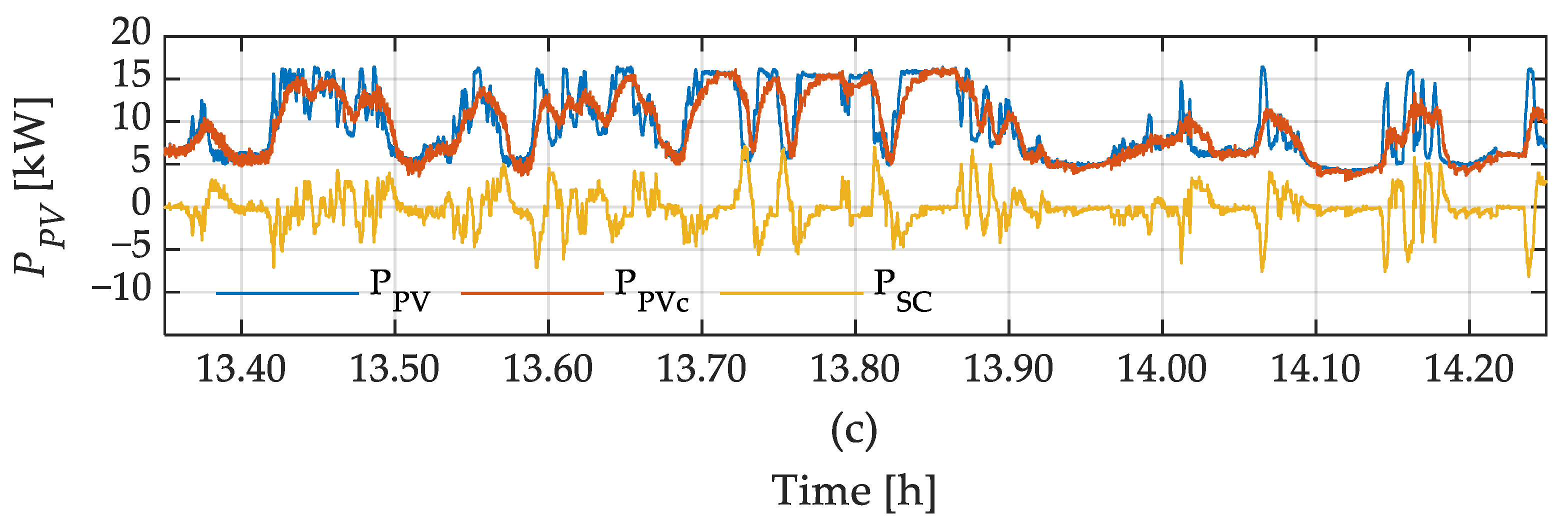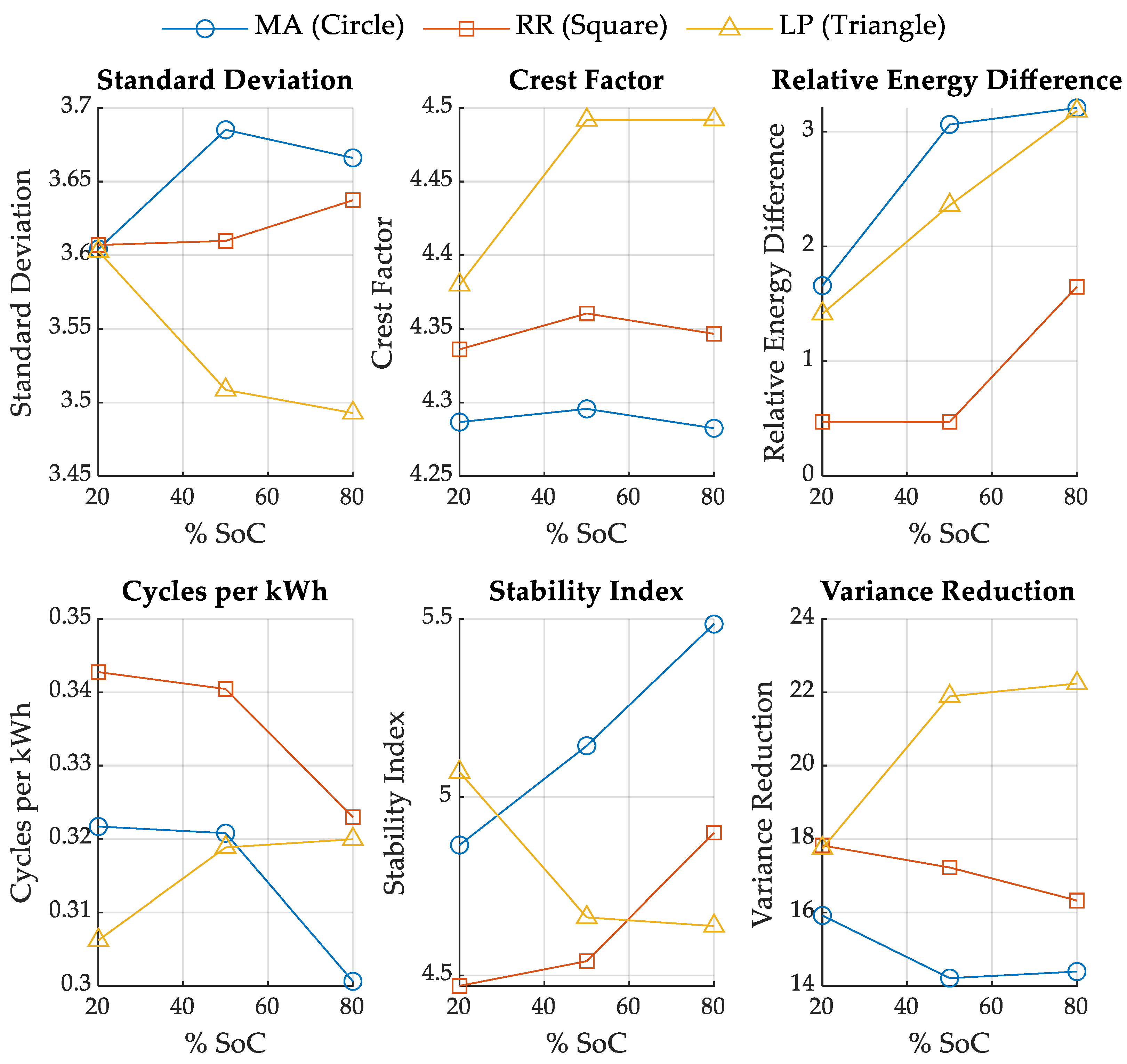1. Introduction
The exponential growth of electric vehicles (EVs) and the integration of renewable energy sources (RES) have transformed modern power systems, highlighting both opportunities and challenges. EVs provide unique energy storage capabilities, while RES promise a clean and sustainable energy supply. However, the intermittent nature of RES and the variable energy demand from EVs introduce significant power fluctuations, compromising the stability and quality of electrical grids [
1]. Low-voltage networks, in particular, are increasingly adopting renewable technologies and Vehicle-to-Grid (V2G) systems, but these face pressing issues of stability and power variability. Such challenges demand advanced solutions. Techniques like fuzzy logic and hybrid energy storage systems have shown promise in mitigating power fluctuations and improving grid reliability [
2]. Still, the variability in the state-of-charge (SoC) of storage systems and the complexity of modern grids require optimized strategies that balance energy quality, storage efficiency, and operational sustainability [
3]. In this context, it becomes crucial to explore innovative approaches to power management and the efficient integration of EVs and RES into weak electrical grids, addressing the challenges of power fluctuations, stability, and energy management.
The integration of EVs and related technologies, such as V2G, is transforming the energy landscape by addressing sustainability and stability challenges in modern power systems. Intelligent control and management systems are vital in this transformation. For instance, a fuzzy logic and artificial neural network-based controller has been proposed to manage communication between charging stations, EVs, and the grid, effectively reducing errors and improving operational stability [
1]. Similarly, coordinated control strategies have been developed to mitigate voltage rise/drop issues at distribution nodes by employing fuzzy logic to generate reference signals and manage power flows at charging stations [
4]. The hybrid approach of integrating EVs with renewable energy sources has proven effective in maintaining stable voltage profiles and minimizing active and reactive power losses in interconnected electrical systems [
5]. In more specific applications, an adaptive strategy for stabilizing isolated grids through the integration of V2G and solar energy has shown promising results by reducing power fluctuations [
2]. Furthermore, a differential evolution-based algorithm has been applied to V2G systems to balance energy costs and battery state-of-charge levels, leveraging photovoltaic (PV) generation forecasts [
6].
Communication quality is also critical for the success of V2G systems. An analysis of communication systems’ impact on grid node voltage highlights the importance of fuzzy logic controllers in environments with multiple charging stations [
7]. In parallel, innovative algorithms such as the Fuzzy Discrete Squirrel Search (FDSS) have optimized charging capacity in networks with limited infrastructure, revealing the role of EVs as backup power sources during renewable energy shortages [
8]. The development of fast-charging stations in DC microgrids has also been explored. Control methods such as sliding mode and fuzzy logic have demonstrated their capability to mitigate voltage sags while improving dynamic performance [
9]. On the other hand, fuzzy logic-based control strategies have been designed to ensure efficient operation in stations integrating PV and battery storage, enabling active and reactive power transfer [
10]. The implementation of V2G technology in microgrids addresses power quality challenges, such as total harmonic distortion (THD), through advanced fuzzy logic controllers that outperform traditional methods like PI controllers [
11]. A more sophisticated approach integrates neural networks and optimization algorithms to manage battery charging and discharging, achieving consistent efficiencies of 97% under various conditions [
12]. Additionally, interval type-2 fuzzy logic-controlled systems have enhanced charging quality and reduced harmonic distortions during bidirectional operations [
13].
The adoption of plug-in electric vehicles has also driven advancements in nonlinear control solutions and genetic optimization algorithms, improving system stability and the longevity of critical components like batteries and electrolyzers [
14]. In the realm of mobility, adaptive control algorithms have optimized energy efficiency and regenerative braking systems while integrating EVs with smart grids and renewable energy sources [
15]. In microgrids with high renewable penetration, hybrid energy management systems have been instrumental in frequency regulation and stability, employing fuzzy logic and deep reinforcement learning to adapt to random disturbances [
16,
17]. Fuzzy logic has also proven to be a powerful tool for managing battery charge/discharge in intelligent energy systems, optimizing energy costs and charging strategies [
18]. The planning of grid-connected low-voltage direct current systems has benefited from multi-objective approaches that consider EV demand response, achieving a balance between cost and carbon emissions through fuzzy optimization methods [
19]. In hybrid energy storage systems, adaptive low-pass filter-based strategies have extended battery life and improved energy distribution in EV-equipped systems [
3,
20].
Advanced controllers, such as adaptive integral sliding mode controllers, have demonstrated their ability to reduce power fluctuations in hybrid systems with multiple energy storage sources [
21]. Predictive strategies based on Markov chain models have effectively managed hybrid systems of batteries and supercapacitors [
22]. For wind power plants, enhanced kinetic energy control and power distribution methods have mitigated energy fluctuations and optimized the use of batteries and capacitors [
23,
24]. Moreover, combined primary frequency regulation and torsional vibration control methods have reduced low-speed shaft fatigue in wind turbines while maintaining frequency stability [
25]. Additionally, advanced DC-link voltage control strategies and standalone systems have improved power quality and robustness in wind energy systems [
26,
27]. In microgrids with large-scale renewable generation, state-of-charge-based adaptive controls have facilitated smooth transitions between operating modes, mitigating transient impacts [
28]. The combination of renewable energy sources and hybrid systems has driven technologies such as solid oxide fuel cells, which store excess energy as hydrogen and ensure continuity in systems with low renewable generation [
29]. Furthermore, fault detection in PV systems using deep learning techniques has significantly enhanced their reliability and operational efficiency [
30].
Despite significant advancements in energy management for V2G systems, several critical gaps remain unaddressed in the literature. Current control strategies leveraging fuzzy logic and evolutionary optimization [
1,
4,
6] have successfully enhanced grid stability in networks with high renewable energy penetration. However, these studies often fail to address the unique operational challenges of weak low-voltage grids characterized by limited capacity, high sensitivity to power fluctuations, and the intermittent nature of PV generation. These grids require tailored solutions capable of dynamically managing variability and ensuring stability under real-world conditions. Existing studies have proposed advanced power smoothing methods [
2,
11], yet few provide a comprehensive evaluation of multiple filtering techniques, such as low-pass, moving average, and ramp rate filters, particularly when optimized with fuzzy logic. This lack of systematic comparison under realistic conditions limits their practical applicability, especially in weak low-voltage networks where environmental and operational constraints amplify power variability. Furthermore, while active SoC management strategies are essential for extending battery lifespan and improving power quality, most studies [
12,
14] evaluate these methods in simplified or idealized scenarios, overlooking the severe fluctuations and high penetration of PV energy typical of weak grids. Finally, although hybrid storage components have been increasingly integrated into energy systems [
4], their deployment remains limited due to the absence of experimental validation that reflects real-world grid dynamics and operational complexities.
This paper directly addresses these gaps by developing and experimentally validating three advanced power smoothing methods—V2GGlide, V2GSUN, and V2GSmooth—optimized with fuzzy logic and designed explicitly for weak low-voltage grids with high renewable penetration. Unlike previous studies, these methods are systematically compared under varying SoC conditions, revealing their relative strengths and limitations in addressing power fluctuations and grid instability. The proposed approach also introduces an innovative strategy for active SoC management in hybrid energy storage systems, ensuring consistent energy quality, maximizing battery lifespan, and optimizing energy utilization across different operating scenarios. Furthermore, the methods are validated experimentally in a low-voltage microgrid laboratory connected to a public distribution network, demonstrating their practical feasibility and scalability. This validation bridges the gap between theoretical advancements and real-world implementation, offering a robust framework for enhancing grid reliability and renewable energy integration. The contributions of this paper extend beyond theoretical development, addressing critical challenges in energy management and system optimization. By providing a comprehensive comparative analysis of power smoothing methods, introducing a novel SoC management strategy, and validating these approaches under realistic conditions, the study documented in this paper establishes a practical foundation for deploying V2G systems in weak grids with high PV penetration. These contributions pave the way for more reliable, sustainable, and scalable integration of renewable energy into modern power networks.
The remainder of this paper is organized as follows:
Section 2 describes the materials and methods, including the system configuration, the fuzzy logic-based smoothing methods (V2GGlide, V2GSUN, and V2GSmooth), and the modeling of membership functions for the lithium-ion battery energy storage system (LI-ION BESS).
Section 3 presents the results, analyzing the performance of each smoothing method under three SoC conditions—high, medium, and low—using key metrics such as variance reduction, standard deviation, and energy delivery.
Section 4 provides a detailed discussion of the results, highlighting the comparative performance of the methods, their dependence on SoC levels, and their implications for grid stability and battery management. Additionally, the limitations of the proposed approach and potential areas for future work are discussed.
Section 5 concludes the paper by summarizing the main findings, emphasizing the effectiveness of the proposed methods, and outlining recommendations for improving power smoothing strategies in weak low-voltage networks.
2. Materials and Methods
Figure 1 illustrates the methodology applied in the study presented in this paper. Initially, input data are gathered from the power generated by PV panels (
) and the conventional generator (
), integrated within an isolated microgrid.
The proposed approach leverages a lithium-ion battery energy storage system (BESS) connected to a bidirectional electric vehicle charging station (EVCS) with Vehicle-to-Grid (V2G) capability. Control is implemented using a fuzzy logic controller (FLC), which dynamically adjusts the smoothing factor (α) of a low-pass filter to smooth power fluctuations in real-time.
The method is evaluated against conventional techniques such as moving average (MA) and ramp rate (RR) filtering. The BESS is connected to the grid through a 50 kW bidirectional inverter, enabling energy flow management and simulating the operation of an electric vehicle, specifically the BYD T3 van used in this analysis.
Finally, the results are experimentally validated by analyzing the system’s variability and efficiency. The findings demonstrate the practical feasibility and effectiveness of the proposed methodology in ensuring microgrid control and stability.
2.1. System Modeling and Membership Functions
In fuzzy logic theory, membership functions play a critical role by mapping input variables to fuzzy values, allowing the system to handle uncertainties inherent in measurements. This section details the mathematical development of these membership functions, including their form and the underlying logic used to classify input data.
2.1.1. Input Variables
The system utilizes two primary input variables:
These variables are modeled using triangular membership functions, which mathematically represent the degree to which the variables belong to different linguistic categories.
2.1.2. Membership Functions for
The variable , representing the battery state-of-charge, ranges from 0 to 100. Its membership functions define five linguistic categories: Very Low (VL), Low (L), Medium (M), High (H), and Very High (VH). The precise formulation of these functions ensures accurate classification of the input data.
2.1.3. Membership Functions for and
The real-time PV power, , is defined within the range 0 and 15. It is modeled using triangular membership functions divided into five linguistic categories: Very Low (VL), Low (L), Medium (M), High (H), and Very High (VH). These categories represent the variability of solar power generation, enabling the fuzzy logic controller to process input data efficiently.
The output α, representing the smoothing factor, is also modeled using triangular membership functions. In this case, α is defined over the range 0 and 10 and categorized into five linguistic labels: Very Low (VL), Low (L), Medium (M), High (H), and Very High (VH). These categories allow the fuzzy controller to generate appropriate smoothing adjustments for power fluctuations.
2.1.4. Inference and Calculation of
The inference process determines the value of
by applying a set of fuzzy rules based on the membership functions of the input variables defined above. The centroid method is used for defuzzification, providing a crisp output value for
:
where
is the
value for a specific rule, and
is the membership degree associated with that rule.
The output power
, which will be injected into the distribution network, is calculated using discrete the low-pass filter formula:
Therefore, to achieve such power, it is necessary for the storage system to deliver the following power:
The ranges used in the membership functions , , and were defined based on the specific capacities of the isolated microgrid evaluated at the Microgrid Laboratory of the University of Cuenca. For example, the output , which represents the smoothing factor, was modeled using triangular membership functions in a range between 0 and 10, with five linguistic labels: Very Low, Low, Medium, High, and Very High. These categories allow power fluctuations to be adjusted according to system conditions.
The minimum and maximum limits of and were established according to the nominal capacities of the solar panels (15 kWp), the storage system (44 kWh), and controlled tests, such as a constant three-phase load of 20 kW and intermittent solar generation. The ranges were validated through MATLAB (R2024b) simulations and real-time testing, ensuring that the fuzzy logic controller responds appropriately to operating conditions.
2.2. Practical Implementation of the Proposal
The pseudocode presented in Algorithm 1 describes the control process based on the low-pass filter (LP, V2GGlide) applied to a power system using fuzzy logic. This method uses as inputs the PV power () and the state-of-charge () of a lithium battery. Initially, the devices are connected using the Modbus protocol to read the initial values of these variables.
Subsequently, a fuzzy inference system (FIS) is defined that includes two input variables, and , and an output variable, , which determines the relative weight between the previous smoothed value and the current value. For these variables, triangular membership functions (trimf) are configured and adapted to their operating ranges. In addition, fuzzy rules are added that allow the FIS to dynamically adjust the value of based on the current system conditions.
During real-time processing, a continuous loop, with a sampling interval of 100 ms, reads the current values from the Modbus devices. The FIS evaluates these values to calculate the
factor and apply the V2GGlide method, which uses a low-pass filter to smooth out PV power fluctuations. The result is a compensated power (
) that is written back to the Modbus devices. In addition, the state-of-charge of the lithium batteries is continuously monitored to ensure system stability. This process is repeated indefinitely, providing efficient, real-time power control while ensuring stable and predictable system behavior.
| Algorithm 1: Pseudocode for implementing the V2GGlide method |
|
|
|
|
3. Results
3.1. Case Study
In this article, algorithms developed in MATLAB were implemented to conduct real-time testing on a real isolated microgrid. The system includes polycrystalline solar panels with an installed capacity of 15 kWp and a lithium-ion based BESS of 44 kWh. The tests were conducted in the Microgrid Laboratory at the University of Cuenca, Ecuador, where an isolated network was configured. This network consisted of PV panels (
), a diesel thermal generator (
), a programmable three-phase load, and an EVCS, all interconnected via inverters operating at 220 V AC [
31].
To ensure controlled energy balance, the programmable three-phase load was set to a constant value of 20 kW, allowing system disturbances to be solely attributed to the intermittent solar generation. Additionally, a BYD T3 electric vehicle, equipped with a 100 kW electric motor and a 50.3 kWh LiNiMnCo battery, was used. Its charging process was recorded to determine the active power profile when connected to the microgrid.
The V2G connection was emulated using a lithium battery bank with 642 VDC and 88 kW, connected to a 50 kW bidirectional converter (see
Figure 2). This system enables both energy injection and extraction in two modes: Grid-to-Vehicle (G2V) and V2G. It also includes functionalities such as peak demand management and power stabilization.
The experimental configuration, featuring real-time control capabilities, provides a robust platform to validate the V2G strategy in isolated microgrids.
In this study, a MATLAB-based configuration and communication protocol were developed using Ethernet Modbus TCP/IP to enable efficient data transfer between sensors, programmable logic controllers (PLCs), and inverters. The system control and monitoring were centralized within a SCADA platform integrated with a LabVIEW interface, ensuring real-time data acquisition, reducing latency issues, and minimizing errors in data processing with a sampling interval of 100 ms.
The electrical measurements critical for evaluating the power smoothing methods were retrieved through the SCADA system from the commercial three-phase inverter BPCS80, manufactured by GPtech. This inverter provides comprehensive electrical readings, including RMS voltage and current, active and reactive power, frequency, DC-link voltage, and the SoC of the lithium-ion battery storage system, as reported by the Battery Management System. The Modbus communication protocol facilitates seamless data exchange between the inverter and the SCADA platform, ensuring continuous monitoring of system performance.
As the effectiveness of the proposed power smoothing method depends on precise measurement of power fluctuations and SoC levels, sensor accuracy becomes vital. According to the manufacturer’s specifications, the tolerance range for voltage and current sensors in the BPCS80 inverter is ±0.5% to ±1% of the measured value. These tolerances introduce minor deviations in the electrical variables, potentially affecting the energy storage system’s compensation response when mitigating photovoltaic power fluctuations. However, as these measurement tolerances remain consistent across all experiments and comparative methodologies, their influence is expected to be systematic rather than introducing significant discrepancies in performance evaluation.
Figure 3 illustrates the behavior of the power generated by a PV system (
) (green curve) operating within the experimental microgrid. The graph reveals the characteristic variability of solar energy production, which is directly influenced by weather conditions throughout the day. Additionally, an emulated profile (blue curve) complements and validates the experimental results. The green curve shows a typical PV generation profile,
, with a gradual increase in power during the early morning hours, peaking around midday, and then declining towards the end of the day. However, abrupt power fluctuations indicate intermittent cloud cover attenuating the solar radiation received by the PV modules. This variability is particularly significant in mountainous regions like Cuenca, where weather conditions can change rapidly.
The blue curve represents an emulated profile generated in the laboratory as part of a modeling process designed to replicate the dynamics of PV systems under controlled conditions. This approach enables the analysis of the impact of climatic variations on generation and validates the methodology used in the microgrid to ensure operational stability and control strategies. Comparing the actual and emulated curves highlights the laboratory’s ability to model dynamic systems with high accuracy.
At the bottom of the graph, images of the sky taken at different times of the day are included, correlating with specific points on the () curve. These photographs demonstrate how cloud cover directly affects PV production. For instance, during hours of clear skies, there is a significant increase in generated power, while during periods of greater cloud cover, generation decreases sharply. This correlation between visual meteorological data and power measurements strengthens the analysis by providing both qualitative and quantitative insights into the impact of weather conditions.
From a technical perspective, this graphical representation shows the importance of evaluating and modeling the dynamic behavior of PV systems in microgrids. The measured data, combined with the emulation, support the proposal of advanced control strategies to mitigate energy generation fluctuations and ensure more stable microgrid operation, particularly in scenarios with high renewable energy penetration.
This work assesses the effectiveness of three fuzzy logic-enhanced power smoothing methods—low-pass (LP, V2GGlide), mean average (MA, V2GSUN), and ramp rate (RR, V2GSmooth)—under three initial SoC conditions for the LI-ION BESS:
The LI-ION BESS is charged to over 80% of its capacity before initiating the smoothing process.
The LI-ION BESS operates within a mid-range SoC, ensuring sufficient energy without reaching overcharge or undercharge limits.
The LI-ION BESS begins the smoothing process with an SoC below 20% of its maximum capacity.
3.2. Power Smoothing Evaluation Using the Mean Average (V2GSUN) Filter Under Varied SoC Conditions
Figure 4 illustrates the response of the LI-ION BESS to PV power fluctuations using the MA (V2GSUN) filter across three SoC conditions:
Case 1 (SoC > 80%): With the LI-ION BESS fully charged, the smoothed power (red line) closely follows the PV power fluctuations (blue line), showing a significant reduction in the variations of power delivered to the grid. Meanwhile, the LI-ION BESS power (yellow line) efficiently adjusts to compensate for these fluctuations, resulting in highly effective smoothing.
Case 2 (SoC ≈ 50%): With a mid-range SoC, the smoothing capacity remains effective; however, more pronounced fluctuations appear due to storage limitations. This leads to a slower response in compensating for power peaks, which is slightly less effective than in Case 1.
Case 3 (SoC < 20%): With a low SoC, the LI-ION BESS lacks sufficient energy to absorb all fluctuations. As a result, the smoothed power (red line) exhibits larger variations, reflecting the system’s difficulty in compensating for PV power variability.
Figure 5 highlights the variability in the SoC of the LI-ION BESS across the three different SoC conditions:
Case 1 (SoC > 80%): The LI-ION BESS maintains a high SoC, ensuring ample capacity to absorb PV power fluctuations. This results in highly efficient and stable power smoothing with minimal SoC variability, indicating optimal system operation.
Case 2 (SoC ≈ 50%): The SoC exhibits more pronounced fluctuations due to the charging and discharging demands required to balance PV power variations. While the smoothing remains effective, the compensation capacity is slightly reduced, resulting in less stable behavior compared to Case 1.
Case 3 (SoC < 20%): With the SoC dropping below 20%, the LI-ION BESS’s ability to absorb fluctuations without deep discharges is significantly limited. This leads to greater SoC variability and less effective smoothing of PV power fluctuations.
Table 1 presents the results of power smoothing using the MA (V2GSUN) filter under three different SoC conditions for the LI-ION BESS.
Case 1: When the initial SoC of the LI-ION BESS is above 80%, the V2GSUN filter achieves a significant reduction in PV power variability, decreasing the variance by 4.4%. Without the LI-ION BESS, the variance of PV power is 15.70, but with the LI-ION BESS, it is reduced to 13.44, indicating efficient fluctuation compensation. Additionally, the MA filter delivers 0.27 kWh more energy to the system compared to the scenario without the LI-ION BESS. However, the total energy delivered (8.15 kWh) is slightly lower than in the case without the LI-ION BESS (8.42 kWh).
Case 2: At an intermediate SoC (approximately 50%), the filter remains effective but less so than in the previous case. The variance without the LI-ION BESS is 15.83, and with the LI-ION BESS, it reduces to 13.58, indicating a reduction in power delivered fluctuations, although the fluctuations are more noticeable than in Case 1. The energy difference is 0.26 kWh more with the LI-ION BESS, but the total energy delivered (8.23 kWh) remains slightly lower compared to the scenario without the LI-ION BESS (8.49 kWh).
Case 3: When the SoC of the LI-ION BESS is low (below 20%), the filter still reduces the variance, but with reduced effectiveness due to storage limitations. The variance without the LI-ION BESS is 15.45, and with the LI-ION BESS, it decreases to 12.99. This suggests that the system is still able to smooth some fluctuations, albeit less efficiently. In terms of energy delivered, the LI-ION BESS provides 0.14 kWh more to the system. However, the difference in total energy delivered (8.30 kWh versus 8.44 kWh without the LI-ION BESS) is smaller. This case demonstrates greater efficiency in deep discharge cycles, with 2.67 cycles compared to 2.45 cycles in the Case 1 scenario (SoC > 80%). This indicates that the LI-ION BESS manages deep discharges more efficiently under low SoC conditions.
3.3. Power Smoothing Evaluation Using the Ramp Rate (V2GSmooth) Filter Under Varied SoC Conditions
Figure 6 illustrates the profiles for PV power (blue line), stored power in the LI-ION BESS (yellow line), and the smoothed power delivered to the grid (red line) using the ramp rate (V2GSmooth) filter under three distinct SoC conditions for the LI-ION BESS.
Case 1 (SoC ≈ 90%): At a high SoC, the LI-ION BESS is fully charged and effectively compensates for PV power fluctuations. The smoothed power demonstrates exceptional stability, closely following the desired ramp rate. The system operates efficiently, achieving a significant reduction in variability while maintaining grid stability.
Case 2 (SoC ≈ 50%): With a mid-range SoC, the smoothing performance remains effective but shows slightly more significant power variations compared to Case 1. The intermediate storage capacity limits the system’s ability to fully compensate for abrupt fluctuations, resulting in a less stable output profile.
Case 3 (SoC < 20%): At a low SoC, the effectiveness of the V2GSmooth filter diminishes considerably. The energy available in the LI-ION BESS is insufficient to absorb the full extent of PV power variations, leading to greater variability in the smoothed power output. The system struggles to adhere to the defined ramp rate, highlighting the limitations of energy storage under deep discharge conditions.
Complementarily,
Figure 7 shows the behavior of the LI-ION BESS SoC in each of the studied cases, confirming that the system operates within a safe charge range (between 20% and 80%). Maintaining this range is essential to ensure the system’s longevity and operational efficiency.
These results emphasize the effectiveness of the ramp rate (V2GSmooth) filter in reducing PV power fluctuations. However, its performance declines as the SoC of the LI-ION BESS decreases. Despite this limitation, the system continues to perform well in compensating for power variations, particularly when the storage operates at higher charge levels.
Table 2 presents the results obtained by applying the ramp rate (V2GSmooth) filter for power smoothing under three different initial SoC conditions of the LI-ION BESS.
Case 1 (SoC > 80%): The filter achieves a reduction in the variability of PV power generation, with the variance decreasing from 15.81 to 13.23, representing a 16.32% reduction. The energy delivered to the grid without the LI-ION BESS is 8.49 kWh, while with the LI-ION BESS, it is 8.36 kWh, indicating a slight difference of 0.14 kWh. This result suggests that at high SoC levels, the system efficiently compensates for fluctuations, albeit with a minor reduction in the total energy delivered.
Case 2 (SoC ≈ 50%): The filter shows an even more significant reduction in variability, with the variance decreasing from 15.74 to 13.03, representing a 17.22% improvement. The energy delivered to the grid without the LI-ION BESS is 8.47 kWh, while with the LI-ION BESS, it is 8.43 kWh, showing a negligible difference of 0.04 kWh. This indicates that the system remains effective in smoothing fluctuations, with minimal energy loss when operating at intermediate SoC levels.
Case 3 (SoC < 20%): Despite the low SoC, the filter continues to reduce variability in PV power generation, with the variance decreasing from 15.64 to 13.01, representing a 17.82% reduction. In this case, the energy delivered to the grid without the LI-ION BESS is 8.46 kWh, and with the LI-ION BESS, it slightly increases to 8.49 kWh, reflecting a small improvement in compensated energy. This outcome highlights the storage system’s ability to enhance energy delivery, even at low charge levels.
3.4. Power Smoothing Evaluation Using the Low-Pass Filter (V2GGlide) Under Varied SoC Conditions
Figure 8 presents the response of the LI-ION BESS when applying the low-pass filter (V2GGlide) under three different SoC conditions (see
Figure 9). The results demonstrate how the PV power fluctuations (blue line) are mitigated by the LI-ION BESS power response (yellow line) to produce a smooth output to the grid (red line). The analysis considers three scenarios: Case 1 (SoC ≈ 90%), Case 2 (SoC ≈ 50%), and Case 3 (SoC < 20%).
In Case 1, with the LI-ION BESS, charged to a high level (above 80%), the smoothing capability is most effective. The system absorbs significant power fluctuations without considerable impact on the output. The red line, representing the smoothed power, closely matches the variations in PV power, achieving near-optimal performance with minimal oscillations.
In Case 2, where the SoC is around 50%, the system continues to perform well in compensating for power fluctuations. However, minor variations appear more visible in the smoothed output due to the intermediate storage capacity of the LI-ION BESS. Although the filter remains efficient, the system’s ability to absorb larger fluctuations is slightly reduced, resulting in minor oscillations in the output.
In Case 3, with the SoC below 20%, the smoothing capability is significantly limited. At this low charge level, the LI-ION BESS struggles to handle substantial power variations. This limitation is reflected in the increased variability of the smoothed output (red line). The system’s response becomes less effective, as the LI-ION BESS cannot absorb fluctuations without engaging in deep discharges, which amplifies the presence of pronounced oscillations in the output.
Table 3 presents the results obtained using the V2GGlide filter, which reduces PV power generation variability through power smoothing under three different SoC levels of the LI-ION BESS.
The results show a significant reduction in power variability, evidenced by a decrease in variance across all evaluated cases:
Case 1 (SoC > 80%): The filter achieves a 22.24% reduction in variance, decreasing from 15.69 without the LI-ION BESS to 12.20 with the LI-ION BESS. This result demonstrates that when the LI-ION BESS is fully charged, the system efficiently smooths PV power fluctuations, delivering a more stable output to the grid. Additionally, there is a slight improvement in energy delivery to the system, with a difference of 0.27 kWh between the scenarios with and without the LI-ION BESS.
Case 2 (SoC ≈ 50%): The variance reduction remains significant at 21.89%, although slightly lower compared to Case 1. This reflects the LI-ION BESS’s ability to compensate for fluctuations even with intermediate storage capacity effectively. In this scenario, the energy delivered is 0.20 kWh higher compared to the case without the LI-ION BESS, indicating the filter’s continued effectiveness in improving energy delivery under mid-range SoC conditions.
Case 3 (SoC < 20%): Although the variance still decreases by 17.74%, the smoothing effectiveness is reduced due to the limited charge of the LI-ION BESS. The system’s ability to compensate for large fluctuations is constrained, resulting in more modest improvements. The energy delivered increases by 0.12 kWh compared to the case without the LI-ION BESS.
4. Discussion
The evaluation of the three methods—V2GGlide (low-pass filter), V2GSUN (moving average filter), and V2GSmooth (ramp rate filter)—under varied SoC levels of the LI-ION BESS provides a comprehensive understanding of their applicability and performance in mitigating PV power variability. All methods demonstrated notable effectiveness in reducing power variance compared to the scenario without the LI-ION BESS, underscoring the critical role of energy storage systems in stabilizing renewable energy generation. Among the methods, V2GGlide proved to be the most effective, achieving a variance reduction of 22.24% at high SoC levels (SoC > 80%), which highlights its superior ability to smooth out power fluctuations when ample storage capacity is available. This result reinforces the suitability of the low-pass filter for scenarios requiring a stable and reliable power output under high storage availability. In contrast, V2GSUN exhibited moderate performance, with a variance reduction of 17.82% at low SoC levels (SoC < 20%), maintaining its effectiveness even under partial charge conditions. However, its performance slightly lagged behind V2GGlide, particularly at lower SoC levels, emphasizing its sensitivity to the storage state. The V2GSmooth filter demonstrated results similar to V2GSUN but offered a slight advantage in energy delivery, particularly under medium and low SoC conditions, indicating its relatively consistent performance in scenarios with moderate power fluctuations. This highlights the recursive filter’s potential as a balanced method for maintaining stable energy output while optimizing energy delivery. Across all methods, the improvement in energy delivery, particularly with V2GGlide and V2GSUN, reflects the active compensation of PV power variability, ensuring a smoother and more reliable supply to the grid. Additionally, the ability of all filters to keep the LI-ION BESS within the optimal SoC range (20–80%) reveals the significance of efficient SoC management to preserve battery longevity and maximize overall system effectiveness.
The V2GGlide method demonstrates superior performance in reducing variance at high state-of-charge (
) levels compared to V2GSUN and V2GSmooth. This performance is mainly due to the implementation of a dynamic low-pass filter, whose smoothing factor (
) is adjusted in real-time by a fuzzy logic system that considers the PV power (
) and the lithium batteries’ state-of-charge (
). This dynamic adjustment allows the system to optimize the stability of the power output, mitigating rapid fluctuations and ensuring stable operation even in scenarios with high renewable energy penetration. As shown in the results (
Table 3), the V2GGlide achieves a variance reduction of 22.24% in the case of
> 80%, significantly outperforming the other methods evaluated. This result highlights the fundamental role of the low-pass filter in improving system performance.
The V2GSmooth method stands out for its focus on mitigating power fluctuations through a power ramp control strategy. By employing predefined rules to limit oscillations, this method eliminates the need for real-time dynamic adjustments, simplifying its implementation while enhancing stability in networks with high renewable energy penetration. Moreover, its robust design effectively minimizes relative energy losses across all levels, even in scenarios where storage capacity is limited. These characteristics make V2GSmooth a reliable and efficient approach for maintaining grid stability. Additionally, its features can be seamlessly integrated into other methodologies by combining them with dynamic systems, such as adaptive fuzzy logic controllers, to enhance further system flexibility and responsiveness under diverse and variable operating conditions.
4.1. Analysis of the Evaluated Metrics for Each Method
Figure 10 compares seven key metrics to evaluate the performance of the three PV power smoothing methods—V2GSUN (moving average filter), V2GSmooth (recursive filter), and V2GGlide (low-pass filter)—under varying initial SoC levels of the LI-ION BESS. Below is a detailed analysis of each metric, highlighting observed trends and their technical relevance.
4.1.1. Standard Deviation
Standard deviation reflects the variability of the delivered power. The results show that the V2GSUN method exhibits significantly higher standard deviation compared to V2GSmooth and V2GGlide, particularly at low SoC levels (<20%). This highlights the superior performance of V2GSmooth and V2GGlide in reducing oscillations, regardless of the system’s charge state, making them more effective for ensuring stable power delivery.
4.1.2. Crest Factor
The crest factor, which measures the ratio between peak power and its RMS value, indicates that V2GGlide demonstrates a more stable behavior with consistently lower values compared to V2GSUN and V2GSmooth, especially at high SoC levels (>80%). This result suggests that V2GGlide is better suited for applications where minimizing power peaks is a priority, as it ensures smoother transitions and reduced peak stress on the grid.
4.1.3. Relative Energy Difference (%)
This metric reveals that V2GSUN and V2GGlide experience higher relative energy losses at low SoC levels (<20%), while V2GSmooth maintains consistently low values across all SoC conditions. This suggests that V2GSmooth is the most efficient method for minimizing energy losses associated with power compensation, particularly under storage constraints.
4.1.4. Cycles per kWh
The number of cycles per kilowatt-hour reflects battery degradation due to energy usage. Results indicate that V2GSmooth has the most favorable behavior, utilizing fewer cycles per unit of delivered energy. This advantage highlights V2GSmooth as the preferred method for extending the operational life of the storage system, as it imposes less stress on the battery over time.
4.1.5. Stability Index
The stability index, defined as the ratio between residual variance and the cycles used, shows that V2GGlide performs better at high SoC levels (>80%). However, V2GSmooth maintains more consistent values across all SoC levels, making it ideal for dynamically changing operating conditions where stability must be ensured regardless of storage availability.
4.1.6. Variance Reduction (%)
Variance reduction is highest with the V2GGlide method, achieving values exceeding 20% at high SoC levels. This result shows the effectiveness of V2GGlide in smoothing power oscillations under favorable charge conditions, making it particularly suitable for scenarios with ample storage capacity.
4.2. Future Work
The scalability of the proposed smoothing methods to real low-voltage networks is feasible, although it requires specific adaptations to address the complexities of these environments. The experimental tests documented in this article were conducted in a low-voltage microgrid laboratory under controlled conditions and connected to the 22 kV public distribution network. This represents a first step toward operation in an actual low-voltage grid. To further scale these methods, it is necessary to improve the monitoring and control infrastructure by implementing advanced sensors capable of providing high-precision, real-time data to account for variables such as load profiles, solar irradiance, and weather conditions. Furthermore, fuzzy logic systems should be generalized to include additional variables, such as temperature and nonlinear load fluctuations, to enhance their flexibility and performance in diverse scenarios. The incorporation of more robust hardware, such as high-capacity PLCs, is also recommended to manage the increased complexity and ensure computational efficiency and system stability. Finally, thorough validation in dynamic environments with varying loads and weather conditions is essential to confirm the robustness and reliability of the proposed methods when applied to practical grids. These adaptations will enable the effective scaling of the smoothing methods, ensuring their applicability in real-world settings while maintaining grid stability and facilitating renewable energy integration.
While this study has demonstrated the effectiveness of fuzzy logic-enhanced power smoothing methods in reducing photovoltaic power variability, the influence of sensor tolerances on the overall system performance remains an important aspect for further investigation. The proposed approach relies on real-time electrical measurements retrieved from the commercial three-phase BPCS80 inverter, which introduces inherent tolerances in voltage, current, and power readings. Given that the key operational variables influencing the system’s response—such as power fluctuations and SoC—are directly obtained from these measurements, it is necessary to assess further how these tolerances may marginally affect the effectiveness of the proposed method in practical scenarios.
A more detailed future study could focus on quantifying the exact impact of measurement uncertainty on power smoothing performance. This could be achieved by conducting statistical analyses to determine whether slight variations in sensor accuracy significantly influence the calculated variance reduction or energy delivery improvements. Additionally, experimental tests with alternative sensing equipment featuring lower measurement tolerances could be performed to compare results and validate whether sensor precision plays a more pronounced role in certain operating conditions. Furthermore, adaptive filtering techniques or real-time data correction algorithms could be explored to minimize the influence of sensor tolerances and further refine the accuracy of power smoothing adjustments.
Integrating advanced state-of-charge () management strategies into the proposed approach have the potential to enhance energy efficiency and extend battery lifespan significantly. One promising avenue involves the use of artificial intelligence (AI)-based predictive models to anticipate charging and discharging patterns, enabling optimized battery operation within the ideal range of 20–80% to prevent overcharging and deep discharges. Additionally, dynamic SoC control systems could adaptively adjust upper and lower SoC limits in response to real-time system conditions, maximizing operational efficiency while safeguarding battery durability. Implementing advanced charging techniques, such as constant current and constant voltage control, would further reduce degradation by precisely regulating charging rates. Lastly, continuous SoC monitoring combined with real-time analysis of critical usage patterns would facilitate adaptive operational adjustments, ensuring optimal system performance and longevity.
Integrating AI into the proposed framework would mark a substantial advancement in predictive control and energy forecasting. Achieving this requires the development of machine learning-based models capable of leveraging historical and real-time data to predict fluctuations in PV generation and energy demand accurately. To support these models, specialized hardware such as GPUs or TPUs must be incorporated, enabling efficient real-time processing of complex AI algorithms. Additionally, existing control platforms, such as MATLAB or LabVIEW, need to be enhanced with AI libraries like TensorFlow or PyTorch to implement advanced machine learning techniques seamlessly. Efficient data management systems are essential to handle large volumes of operational data, ensuring precise model training and validation. Finally, thorough experimental validation in real-world environments—particularly in smart grids with high renewable energy penetration—is a critical step to confirm the robustness and accuracy of the AI-enhanced framework.
5. Conclusions
The study results reported in this paper demonstrate that fuzzy logic-enhanced power smoothing methods combined with LI-ION BESS are highly effective in mitigating PV power variability and improving grid stability. The comparative analysis of V2GGlide (low-pass filter), V2GSUN (moving average filter), and V2GSmooth (ramp rate filter) reveals that all three methods successfully reduce power variance and enhance energy delivery to the grid, though their effectiveness strongly depends on the SoC of the storage system. V2GGlide stands out for achieving the most significant variance reduction, reaching 22.24% at high SoC levels (above 80%), where the system efficiently absorbs large power fluctuations while delivering an additional 0.27 kWh of energy. This makes V2GGlide particularly suitable for applications prioritizing maximum variance reduction and stability under favorable battery conditions. V2GSUN, while less effective under low SoC conditions, remains a consistent performer with a variance reduction of up to 17.82% at SoC levels below 20% and improved energy delivery of 0.20 kWh under moderate SoC levels, making it a practical option for systems with intermediate energy availability. V2GSmooth offers a balanced performance across all SoC conditions, achieving variance reductions comparable to V2GSUN and demonstrating higher efficiency in energy delivery and battery utilization, particularly at low SoC levels, where it reduces variance by 17.74% while improving energy output by 0.12 kWh. This consistent performance across varying SoC levels makes V2GSmooth a reliable choice for dynamic operational environments where storage availability fluctuates. A key outcome of this work is the critical dependence of power smoothing effectiveness on the SoC level, with optimal results obtained when the LI-ION BESS operates within a charge range of 20% to 80%. Outside this range, particularly at low SoC, the system’s capacity to compensate for large power fluctuations is significantly limited, leading to increased variability and reduced energy delivery improvements. These findings confirm that maintaining efficient SoC management is essential for maximizing the benefits of power smoothing techniques and ensuring stable grid integration of intermittent PV energy. It is important to note in all the study cases that power smoothing techniques inherently result in slight deviations of the active power supplied by the renewable generator from its nominal value. However, this trade-off is outweighed by the significant benefits of reduced variability, which enhances grid stability and supports the integration of renewable energy sources into the grid.
Finally, while the proposal successfully achieved its objectives, it also acknowledges certain limitations; for instance, the dependence on controlled laboratory conditions, which may not fully capture the complexities of real-world grid operations, especially in environments with higher renewable penetration and more diverse load profiles. Future work should focus on integrating these methods with advanced dynamic SoC management strategies and adaptive control systems, including predictive techniques and artificial intelligence-driven energy forecasting, to further enhance system performance. Additionally, incorporating hybrid energy storage solutions and validating these approaches in larger-scale microgrids will be critical for extending their applicability to real-world scenarios.
